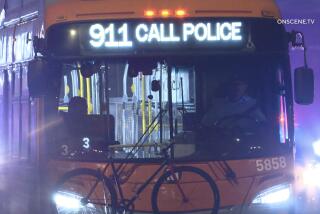Commuters Grapple With Loss of Services
- Share via
To prepare herself for a morning commute complicated by the MTA strike, Fathy Shokrollahi set her alarm clock for 6:10 a.m. Wednesday, an hour and a half earlier than usual.
She caught a Metrolink train from Tustin to Union Station, then shouldered her way onto a crowded shuttle bus that was ferrying passengers who normally take the Red Line subway.
But 10 minutes after her 9 a.m. shift at a physical therapist’s office near Wilshire Boulevard and Western Avenue was scheduled to begin, Shokrollahi, 45, realized her plan had a fatal flaw -- her job was more than a one-mile walk from the shuttle’s last stop.
“It’s not going to work this way,” she said, with a muttered vow to drive to work today.
Shokrollahi’s dilemma was one of thousands that played out across Los Angeles County as commuters tried, with varying degrees of success, to make on-the-fly adjustments to lives and schedules arranged around a public transportation system crippled by striking workers.
Now entering its third day, the strike by mechanics of the Amalgamated Transit Union, Local 1277, has halted service on scores of bus, subway and light rail routes. MTA drivers, supervisors and clerks are also supporting the walkout, which added an ironic twist to Jimmy Amores’ morning.
Amores, a 54-year old driver for the Pasadena Area Rapid Transit system, was forced to drive to work from Highland Park instead of taking the MTA’s Gold Line, as he had three days a week since the line opened in July. Amores’ nonunion bus line is unaffected by the strike, but as he passed the time with other drivers in a cramped break room, he lamented the inconvenience of having to drive to work, a stone’s throw from the Gold Line’s newly deserted Allen station.
“I only have five hours’ parking around here, and I’ve already gotten one ticket,” Amores said. “I don’t want to drive.”
As many as 400,000 riders a day had been using transportation provided by the MTA, which stretches in some form across most of sprawling L.A. County. The ripple effects of the sudden halt were plainly visible Wednesday at the system’s symbolic and physical hub, downtown’s Union Station.
Frank Howard, a Kaiser Permanente computer technician, braved the morning gloom with a bemused grin as he waited at Union Station with other Kaiser employees to board a company shuttle bus to Pasadena.
For the last four years, Howard, 53, has commuted by train from Santa Fe Springs, taking a MetroLink train to Union Station and then transferring to a Kaiser shuttle bus (until July when he switched to the Gold Line) for the last leg of his trip. The strike has forced Kaiser to reinstate its downtown-to-Pasadena shuttle bus for employees.
Despite the delays and uncertainties the strike adds to his commute, however, Howard voiced support for the union action.
“I think it’s something that has to be done,” he said.
Less sympathetic to the strikers’ cause was Gurdeep Dailey, a self-employed engineer who for the last four years has caught a Metrolink train from Burbank to Union Station and then transferred to the MTA’s Red Line to get to her office near MacArthur Park.
Although Metrolink trains are unaffected by the strike, they got Dailey, 45, only as far as Union Station on Wednesday. From there, she was herded onto a standing-room-only shuttle bus dubbed the “Red Line Special,” one of 20 such buses chartered by Metrolink to provide stopgap transportation to some Red Line destinations.
As a longtime user of public transportation, Dailey said she had not been surprised by the strike.
“I expect it, but I don’t agree with it,” she said. “I think they’re paying about $6 a month for health insurance. The rest of us pay a lot more than that, so I think they have to be realistic.”
Steering the “Red Line Special” bus west along 7th Street with his eyes hidden behind a pair of sunglasses, the driver, Jose Chavez, did his best to guide flustered passengers on their way, sometimes with specific directions and sometimes with a vague wave of his hand.
“We try helping,” said Chavez, 37, who normally spends his days driving to amusement parks. “But people are mad because there’s a lot of problems. Everybody’s confused.”
More to Read
Sign up for Essential California
The most important California stories and recommendations in your inbox every morning.
You may occasionally receive promotional content from the Los Angeles Times.










